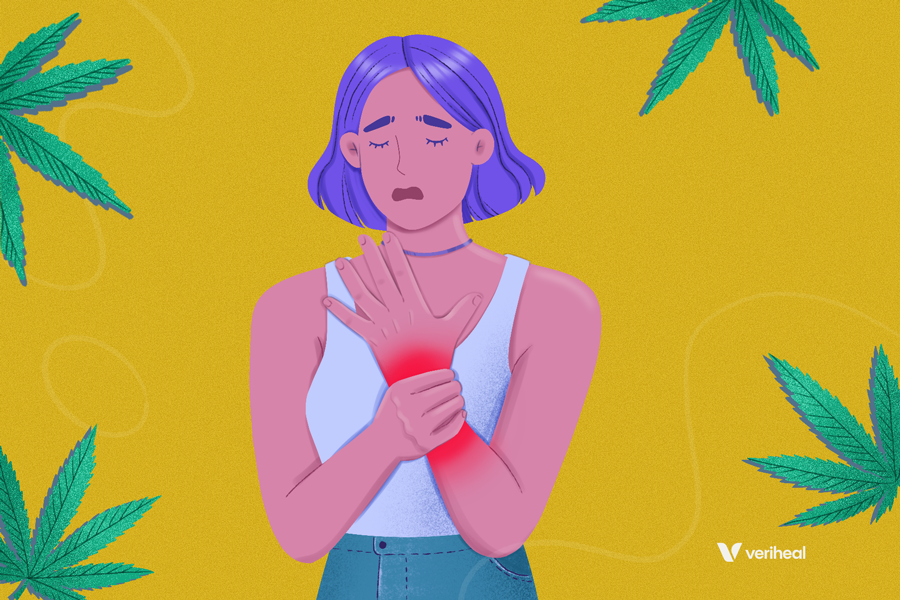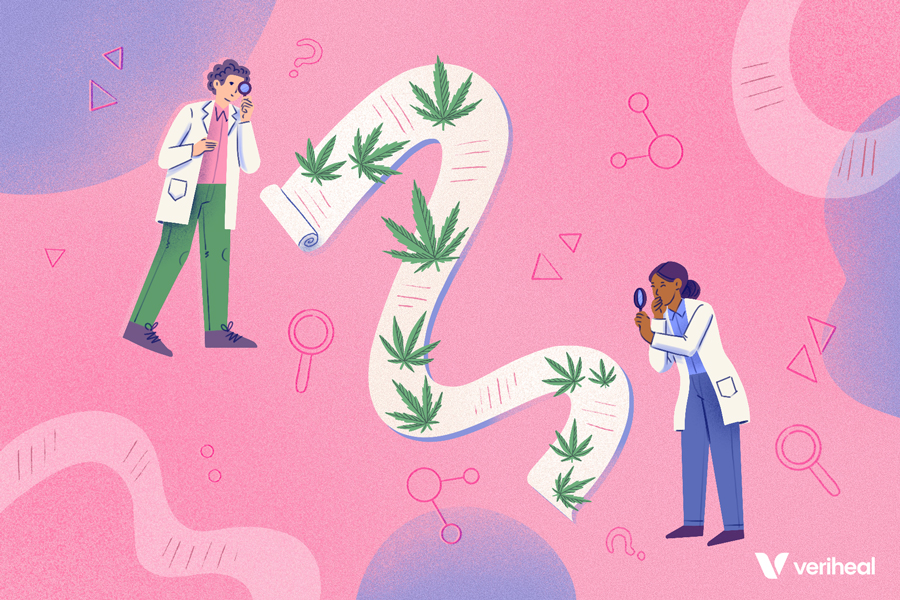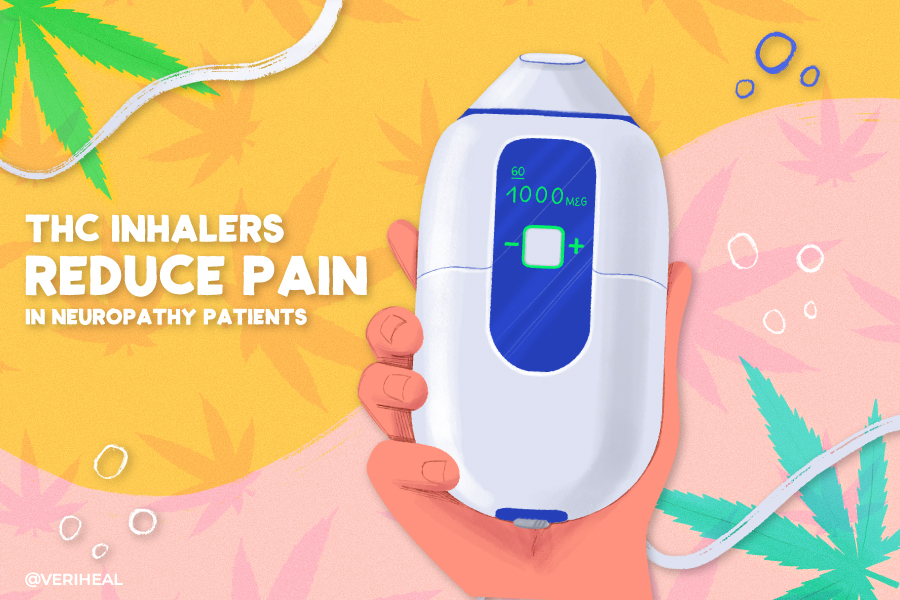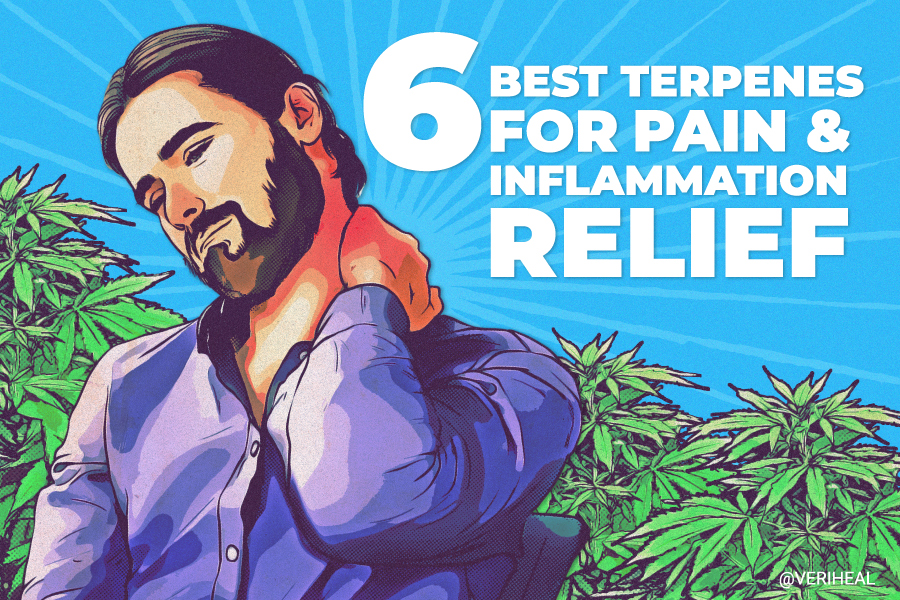Medical Marijuana for Acute Pain What is the Hype About?
Pain is an unpleasant experience, despite the fact that acute pain is actually beneficial to us at times. When someone is running and gets an injury, or experiences a fall, the pain actually serves as a warning sign that something is wrong with the body and that it’s time to stop and assess the situation. Medical cannabis is known for its ability to decrease chronic pain, inflammation, and neuropathy, but can it help with acute pain?
Inside our bodies, we have a bodily system known as the endocannabinoidome (eCBome). This system is activated by medical cannabis and its cannabinoids, including Δ9-tetrahydrocannabinol (THC) and cannabidiol (CBD). When cannabinoids are ingested, they enter the bloodstream and make contact with a variety of receptors located in different parts of the body. These receptors including cannabinoid receptors CB1 & CB2, peroxisome proliferator-activated receptors, and transient receptor potential (TRP) receptors increase or decrease the levels of endocannabinoids in our body.
Endocannabinoids are fat-based neurotransmitters that tell the body how to do certain essential tasks. The body naturally produces and uses endocannabinoids, but they can be modulated with medical-use cannabis. The eCBome plays a role in everyday functions of the body, influencing appetite, inflammation, and pain perception.
What’s the Deal with Acute Pain?
Acute pain happens suddenly and can result from a physical injury or a sudden illness. This type of pain can start out as sharp or intense, serving as a warning to the body that there is a physical threat or as a sign of an underlying medical issue (2). Acute pain also occurs after surgeries, dental work, burns, broken bones, and blunt trauma. It can involve the following pain and nerve sensations (2):
- Throbbing
- Burning
- Stabbing pain
- Weakness
- Numbness
- Tingling
Sometimes it can feel more convenient to ignore acute pain in hopes that it will go away. Sometimes the pain goes away, or it might simply need treatment with non-steroidal anti-inflammatory drugs (NSAIDs) like ibuprofen. The reality is that acute pain can become more severe or turn into chronic pain if it is not treated appropriately (45).
It can sometimes be difficult to get adequate pain treatments for acute pain. Sometimes this can be because patients simply are not able to access stronger pain medications due to physician concerns over opioid dependence. Narcotics, including opioids such as oxycodone, can also cause unwanted side effects such as nausea, constipation, sedation, and other adverse effects.
Other times patients may not report that their medications do not provide a significant difference in pain relief, or they simply forget to take medications as prescribed (45).
Several medical conditions cause acute or short-term pain. These causes are not limited to but include:
- Back pain
- Joint pain
- Tendinitis
- Phantom limb pain
- Sickle cell disease
- Spasmodic torticollis
- Muscle cramps & spasms
- Multiple sclerosis
- Spinal cord injuries
- Carpal tunnel syndrome
- Sciatica
- Spasticity
Types of Pain Relieved by Medical Cannabis
In addition to acute pain, there are several other types of pain conditions. Understanding the differences between these types is important when describing the pain you are experiencing to your doctor. Different types of pain stem from different pain mechanisms in the body, which is why there is no one specific treatment (14).
Medical cannabis and CBD have been shown to be effective analgesics in helping pain management when it interacts with CB1 and CB2 receptors in the body’s endocannabinoid system. The effects of cannabis within the endocannabinoid system can impact the perception of pain.
Chronic Pain
Chronic pain occurs when a patient has been experiencing the same pain for over 3 to 6 months (16). Pain turns chronic when the damaged or affected tissue repeatedly undergoes an inflammatory process (14). This process can lead to arthritis and other complex pain disorders.
The immune system is responsible for healing damaged portions of the body by sending immune cells to the location of the injury in order to heal it. Unfortunately, sometimes the immune cells are unable to heal the injury, and chronic pain may result. Other times, the immune cells get confused and attack healthy tissues instead of healing them.
A 2022 review of cannabis and chronic, noncancer, musculoskeletal orthopedic pain supports the possible benefits of cannabis and its analgesic effects (21). It found that cannabis reduces pain, improves mental and physical health, and improves the quality of life in this patient set. The benefits appear within three months of regular cannabis use and then plateau. Patients may also be able to reduce opioid and benzodiazepine prescriptions, even at non-intoxicating levels of cannabis.
Please check out our chronic pain page for more information on how to use medical cannabis to manage it.
Neuropathic Pain
Neuropathy or nerve pain is caused by an injury or damage to nerves in the body. When the nerves are damaged or simply pinched, the nerves spontaneously fire or become altered to how pain is perceived (14). There are different types and causes of nerve pain, but it often results in pain that feels like burning, tingling, or numbness (52).
This type of pain is very commonly seen in patients with advanced diabetes. THC has shown efficacy in clinical randomized controlled trials with diabetic patients using THC in both low and high doses (8).
Check out our neuropathy page for more information.
Nociceptive Pain
This type of pain is caused by injury to the tissues of our body, which include the skin and organs (52). Acute pain is considered a type of nociceptive pain (16). It can be further divided into somatic and visceral pain. Somatic pain can occur as a result of an acute or chronic injury (14). Somatic pain can cause sharp or burning pain when the skin is damaged or it can cause throbbing or aching pain when deeper tissues such as the joints, tendons, or muscles are affected.
Visceral pain comes from damage to deeper tissues such as the gastrointestinal tract or other organs (14).
Recommendations for Relieving Pain
The guidelines for treating pain released during 2020 PAINWeek also serve well for patients with acute pain. These guidelines include (9):
- Patients are recommended to begin CBD-only treatments at twice daily 5 mg doses.
- THC doses for pain begin at 2.5mg doses a day.
- Patients who are elderly, have comorbid conditions, or are taking several different medications are advised to start at 1mg of THC daily and slowly increase doses.
- Patients with severe pain or prior medical cannabis use are recommended to begin with a 1:1 CBD to THC balanced dose between 2.5 mg and 5mg once or twice daily.
It is important to note that while these doses may appear to be small, medical cannabis can still help relieve your pain in lieu of opioid use or other pain medicines. Feeling the psychoactive effects of THC is not necessary to get relief from pain with marijuana use.
Medical cannabis and CBD-only products are also available in several different forms to fit your needs. It is available in full-spectrum flower, edibles, tinctures, oils, and topical products.
Patients who are suffering from menstrual pain or endometriosis for example, often choose to use suppositories containing CBD and THC.
What Does the Science Say About Cannabinoids & Acute Pain?
A 2020 review published in Cannabis and Cannabinoid Research reviewed the results from six different clinical trials examining cannabinoid use for acute pain (20). Five of the studies focused on the use of oral cannabinoids versus placebo. The remaining study examined the use of intramuscular cannabinoid injections for acute pain.
The review found small, but statistically significant results showing favoring the use of orally administered cannabinoids for reducing acute pain (20). The study focusing on intramuscular cannabinoids found a significant reduction in pain scores over the placebo.
It is important to note that these studies are typically small-scale studies that occur over a short period of time. Larger-scale and longer-term research is still needed in order to accurately assess the effectiveness of cannabinoids for patients with acute pain. Many of these studies did not measure effectiveness past 24 hours (20).
Cannabinoids for Surgical Pain
Because of its effects on chronic pain, many patients and researchers are hoping to learn more about if medical marijuana is an effective option for acute pain that occurs after surgical procedures. Unfortunately, the results of studies focusing on post-surgical pain and cannabinoids are still mixed.
Research presented at the American Academy of Orthopaedic Surgeons (AAOS) 2022 annual conference, showed that patients may benefit from the use of CBD after surgery (47). This systematic review focused on the use of a sublingual, dissolving pill called Oravexx, a CBD-based pharmaceutical prescription that is orally absorbed and is still being studied for use in the United States. This study had 99 rotator cuff surgery participants who received a low dose of Percocet and Oravexx or a placebo after the procedure.
Participants did not know if they received a placebo or the Oravexx and were prescribed to take their assigned medication 3 times a day for 14 days after the surgery (47). Patients who received Oravexx reported 23% lower visual analog scale (VAS) pain scores and up to 25% more satisfaction with their post-surgical pain control.
In 2006, a double-blind and placebo-controlled study set out to answer the question of if using nabilone could be effective in postoperative pain (7). Nabilone is a synthetic cannabis-based medicine available for treating nausea in HIV patients and patients receiving chemotherapy as a cancer treatment. The study recruited 40 patients who received either ketoprofen, 1mg or 2 mg doses of nabilone, or a placebo.
Researchers in this study were unable to prove their hypothesis that nabilone would decrease postoperative pain and instead found that pain levels were significantly higher in the patients who received the 2 mg nabilone doses in comparison to the other groups (7).
A study presented at the 2022 annual meeting of the American Society of Anesthesiologists analyzed the medical records of 34,521 patients in regard to their post-surgical pain (13). There were 1,681 marijuana users in this group who reported using cannabis in the 30 days prior to the surgery. These patients experienced 14% more pain in the first 24 hours after surgery than non-cannabis users. They also consumed 7% more opioids after surgery, which is likely related, but not clinically relevant.
The results of this study regarding cannabis use and post-surgical pain are significant. Though we do not know how much cannabis the 1,681 patients were taking during the month leading up to surgery, the results are significant because this study used a large set of patients and many studies do not encompass such a large data set (13).
The use of medical cannabis for pain after surgery requires more research for doctors in order to give quality recommendations to their patients. The results from the post-surgical review above are interesting because several studies support the use of cannabis and opioids together because they can provide complete pain relief (48).
Important Notes on Cannabis Use & Surgery
Regardless of how much cannabis a patient has used, it is extremely important to let your clinician, surgeon, and anesthesiologist know about it before the surgery. This is for several reasons including that many patients who use cannabis will need more anesthetics to put them under for the procedure (49).
It may also take longer for your stomach to empty before the surgery, increasing the risk of inhaling stomach contents into the lungs during the procedure. Additionally, there is an increased risk of a heart attack in patients with cardiovascular diseases who have consumed cannabis within an hour of receiving anesthesia (49).
Note: Veriheal does not intend to give this as professional medical advice. Do not attempt to self-diagnose, or prescribe treatment based on the information provided on this page. Always consult a physician before making any decision on the treatment of a medical condition.
1. Abdallah, F. W., Hussain, N., Weaver, T., & Brull, R. (2020). Analgesic efficacy of cannabinoids for acute pain management after surgery: A systematic review and meta-analysis. Regional Anesthesia & Pain Medicine, 45(7), 509–519. https://doi.org/10.1136/rapm-2020-101340
2. Acute Pain. (n.d.-a). International Association for the Study of Pain (IASP). Retrieved May 4, 2023, from https://www.iasp-pain.org/resources/topics/acute-pain/
3. Acute Pain: Assessment and Treatment. (n.d.-b). Medscape. Retrieved May 4, 2023, from https://www.medscape.com/viewarticle/735034
4. Amaechi, O., Human, M. M., & Featherstone, K. (2021). Pharmacologic Therapy for Acute Pain. American Family Physician, 104(1), 63–72. https://www.aafp.org/pubs/afp/issues/2021/0700/p63.html
5. Anesthesiologists, A. S. of. (n.d.). Cannabis use increases pain after surgery, study shows. Retrieved May 8, 2023, from https://medicalxpress.com/news/2022-10-cannabis-pain-surgery.html
6. Badiola, I., Doshi, A., & Narouze, S. (2022). Cannabis, cannabinoids, and cannabis-based medicines: Future research directions for analgesia. Regional Anesthesia & Pain Medicine, 47(7), 437–444. https://doi.org/10.1136/rapm-2021-103109
7. Beaulieu, P. (2006). Effects of nabilone, a synthetic cannabinoid, on postoperative pain. Canadian Journal of Anaesthesia = Journal Canadien D’anesthesie, 53(8), 769–775. https://doi.org/10.1007/BF03022793
8. Bennici, A., Mannucci, C., Calapai, F., Cardia, L., Ammendolia, I., Gangemi, S., Calapai, G., & Griscti Soler, D. (2021). Safety of Medical Cannabis in Neuropathic Chronic Pain Management. Molecules, 26(20), 6257. https://doi.org/10.3390/molecules26206257
9. Bhaskar, A., Bell, A., Boivin, M., Briques, W., Brown, M., Clarke, H., Cyr, C., Eisenberg, E., de Oliveira Silva, R. F., Frohlich, E., Georgius, P., Hogg, M., Horsted, T. I., MacCallum, C. A., Müller-Vahl, K. R., O’Connell, C., Sealey, R., Seibolt, M., Sihota, A., … Moulin, D. E. (2021). Consensus recommendations on dosing and administration of medical cannabis to treat chronic pain: Results of a modified Delphi process. Journal of Cannabis Research, 3(1), 22. https://doi.org/10.1186/s42238-021-00073-1
10. Borgelt, L. M., & Franson, K. L. (2017). Considerations for Hospital Policies Regarding Medical Cannabis Use. Hospital Pharmacy, 52(2), 89–90. https://doi.org/10.1310/hpj5202-89
11. Britch, S. C., Wiley, J. L., Yu, Z., Clowers, B. H., & Craft, R. M. (2017). Cannabidiol-Δ9-tetrahydrocannabinol interactions on acute pain and locomotor activity. Drug and Alcohol Dependence, 175, 187–197. https://doi.org/10.1016/j.drugalcdep.2017.01.046
12. Buggy, D. J., Toogood, L., Maric, S., Sharpe, P., Lambert, D. G., & Rowbotham, D. J. (2003). Lack of analgesic efficacy of oral delta-9-tetrahydrocannabinol in postoperative pain. Pain, 106(1–2), 169–172. https://doi.org/10.1016/s0304-3959(03)00331-2
13. Cannabis use increases pain after surgery, study shows. (n.d.). Retrieved May 8, 2023, from https://www.asahq.org/about-asa/newsroom/news-releases/2022/10/cannabis-use-increases-pain-after-surgery-study-shows
14. Chen, J. (Steven), Kandle, P. F., Murray, I. V., Fitzgerald, L. A., & Sehdev, J. S. (2023). Physiology, Pain. In StatPearls. StatPearls Publishing. http://www.ncbi.nlm.nih.gov/books/NBK539789/
15. Cuttler, C., LaFrance, E. M., & Craft, R. M. (2022). A Large-Scale Naturalistic Examination of the Acute Effects of Cannabis on Pain. Cannabis and Cannabinoid Research, 7(1), 93–99. https://doi.org/10.1089/can.2020.0068
16. Dydyk, A. M., & Grandhe, S. (2023). Pain Assessment. In StatPearls. StatPearls Publishing. http://www.ncbi.nlm.nih.gov/books/NBK556098/
17. Eskander, J., Spall, J., Spall, A., Shah, R., & Kaye, A. (2020). Cannabidiol (CBD) as a treatment of acute and chronic back pain: A case series and literature review. Journal of Opioid Management, 16, 215–218. https://doi.org/10.5055/jom.2020.0570
18. First, L., Douglas, W., Habibi, B., Singh, J. R., & Sein, M. T. (2020). Cannabis Use and Low-Back Pain: A Systematic Review. Cannabis and Cannabinoid Research, 5(4), 283–289. https://doi.org/10.1089/can.2019.0077
19. Fisher, E., Eccleston, C., Degenhardt, L., Finn, D. P., Finnerup, N. B., Gilron, I., Haroutounian, S., Krane, E., Rice, A. S. C., Rowbotham, M., Wallace, M., & Moore, R. A. (2019). Cannabinoids, cannabis, and cannabis-based medicine for pain management: A protocol for an overview of systematic reviews and a systematic review of randomised controlled trials. Pain Reports, 4(3), e741. https://doi.org/10.1097/PR9.0000000000000741
20. Gazendam, A., Nucci, N., Gouveia, K., Abdel Khalik, H., Rubinger, L., & Johal, H. (2020). Cannabinoids in the Management of Acute Pain: A Systematic Review and Meta-analysis. Cannabis and Cannabinoid Research, 5(4), 290–297. https://doi.org/10.1089/can.2019.0079
21. Greis, A., Larsen, E., Liu, C., Renslo, B., Radakrishnan, A., & Wilson-Poe, A. R. (2022). Perceived Efficacy, Reduced Prescription Drug Use, and Minimal Side Effects of Cannabis in Patients with Chronic Orthopedic Pain. Cannabis and Cannabinoid Research, 7(6), 865–875. https://doi.org/10.1089/can.2021.0088
22. Grossman, S., Tan, H., & Gadiwalla, Y. (2022). Cannabis and orofacial pain: A systematic review. British Journal of Oral and Maxillofacial Surgery, 60(5), e677–e690. https://doi.org/10.1016/j.bjoms.2021.06.005
23. Haleem, R., & Wright, R. (2020). A Scoping Review on Clinical Trials of Pain Reduction With Cannabis Administration in Adults. Journal of Clinical Medicine Research, 12(6), 344–351. https://doi.org/10.14740/jocmr4210
24. Hill, K. P., Palastro, M. D., Johnson, B., & Ditre, J. W. (2017). Cannabis and Pain: A Clinical Review. Cannabis and Cannabinoid Research, 2(1), 96–104. https://doi.org/10.1089/can.2017.0017
25. Holdcroft, A., Maze, M., Doré, C., Tebbs, S., & Thompson, S. (2006). A Multicenter Dose-escalation Study of the Analgesic and Adverse Effects of an Oral Cannabis Extract (Cannador) for Postoperative Pain Management. Anesthesiology, 104(5), 1040–1046. https://doi.org/10.1097/00000542-200605000-00021
26. Is Your Pain Acute or Chronic? WebMD. Retrieved May 4, 2023, from https://www.webmd.com/pain-management/features/types-pain
27. Jain, A. K., Ryan, J. R., McMahon, F. G., & Smith, G. (1981). Evaluation of intramuscular levonantradol and placebo in acute postoperative pain. Journal of Clinical Pharmacology, 21(S1), 320S-326S. https://doi.org/10.1002/j.1552-4604.1981.tb02610.x
28. Johal, H., Devji, T., Chang, Y., Simone, J., Vannabouathong, C., & Bhandari, M. (2020). Cannabinoids in Chronic Non-Cancer Pain: A Systematic Review and Meta-Analysis. Clinical Medicine Insights. Arthritis and Musculoskeletal Disorders, 13, 1179544120906461. https://doi.org/10.1177/1179544120906461
29. Johnson, Q., Borsheski, R. R., & Reeves-Viets, J. L. (2013). A Review of Management of Acute Pain. Missouri Medicine, 110(1), 74–79. https://www.ncbi.nlm.nih.gov/pmc/articles/PMC6179627/
30. Kalliomäki, J., Segerdahl, M., Webster, L., Reimfelt, A., Huizar, K., Annas, P., Karlsten, R., & Quiding, H. (2013). Evaluation of the analgesic efficacy of AZD1940, a novel cannabinoid agonist, on post-operative pain after lower third molar surgical removal. Scandinavian Journal of Pain, 4(1), 17–22. https://doi.org/10.1016/j.sjpain.2012.08.004
31. King, D. D., Stewart, S. A., Collins-Yoder, A., Fleckner, T., & Price, L. L. (2021). Anesthesia for Patients Who Self-Report Cannabis (Marijuana) Use Before Esophagogastroduodenoscopy: A Retrospective Review. AANA Journal, 89(3), 205–212. https://www.ncbi.nlm.nih.gov/pmc/articles/PMC8764743/
32. Kraft, B., Frickey, N. A., Kaufmann, R. M., Reif, M., Frey, R., Gustorff, B., & Kress, H. G. (2008). Lack of Analgesia by Oral Standardized Cannabis Extract on Acute Inflammatory Pain and Hyperalgesia in Volunteers. Anesthesiology, 109(1), 101–110. https://doi.org/10.1097/ALN.0b013e31817881e1
33. Levin, D. N., Dulberg, Z., Chan, A.-W., Hare, G. M. T., Mazer, C. D., & Hong, A. (2017). A randomized-controlled trial of nabilone for the prevention of acute postoperative nausea and vomiting in elective surgery. Canadian Journal of Anaesthesia = Journal Canadien D’anesthesie, 64(4), 385–395. https://doi.org/10.1007/s12630-017-0814-3
34. Lynch, M. E., & Clark, A. J. (2003). Cannabis Reduces Opioid Dose in the Treatment of Chronic Non-Cancer Pain. Journal of Pain and Symptom Management, 25(6), 496–498. https://doi.org/10.1016/S0885-3924(03)00142-8
35. MacCallum, C., & Russo, E. (2018). Practical considerations in medical cannabis administration and dosing. European Journal of Internal Medicine, 49. https://doi.org/10.1016/j.ejim.2018.01.004
36. Madden, K., George, A., van der Hoek, N. J., Borim, F. M., Mammen, G., & Bhandari, M. (2019). Cannabis for pain in orthopedics: A systematic review focusing on study methodology. Canadian Journal of Surgery, 62(6), 369–380. https://doi.org/10.1503/cjs.001018
37. McAfee, J., Boehnke, K. F., Moser, S. M., Brummett, C. M., Waljee, J. F., & Bonar, E. E. (2021). Perioperative cannabis use: A longitudinal study of associated clinical characteristics and surgical outcomes. Regional Anesthesia & Pain Medicine, 46(2), 137–144. https://doi.org/10.1136/rapm-2020-101812
38. Neuropathic Pain—Neurologic Disorders. (n.d.). Merck Manuals Professional Edition. Retrieved May 4, 2023, from https://www.merckmanuals.com/professional/neurologic-disorders/pain/neuropathic-pain
39. Optimizing the Treatment of Acute Pain in the Emergency Department. (2017). Annals of Emergency Medicine, 70(3), 446–448. https://doi.org/10.1016/j.annemergmed.2017.06.043
40. Pantoja-Ruiz, C., Restrepo-Jimenez, P., Castañeda-Cardona, C., Ferreirós, A., & Rosselli, D. (2022). Cannabis and pain: A scoping review. Brazilian Journal of Anesthesiology, 72, 142–151. https://doi.org/10.1016/j.bjane.2021.06.018
41. Post-Op Pain Control More Challenging for Cannabis Users. (2022, October 22). https://www.medpagetoday.com/meetingcoverage/asa/101365
42. Quinlan, J., & Cox, F. (2017). Acute pain management in patients with drug dependence syndrome. Pain Reports, 2(4), e611. https://doi.org/10.1097/PR9.0000000000000611
43. Schiano Moriello, A., Di Marzo, V., & Petrosino, S. (2022). Mutual Links between the Endocannabinoidome and the Gut Microbiome, with Special Reference to Companion Animals: A Nutritional Viewpoint. Animals, 12(3), Article 3. https://doi.org/10.3390/ani12030348
44. Schneider-Smith, E., Salottolo, K., Swartwood, C., Melvin, C., Madayag, R. M., & Bar-Or, D. (2020). Matched pilot study examining cannabis-based dronabinol for acute pain following traumatic injury. Trauma Surgery & Acute Care Open, 5(1), e000391. https://doi.org/10.1136/tsaco-2019-000391
45. Sinatra, R. (2010). Causes and Consequences of Inadequate Management of Acute Pain. Pain Medicine, 11(12), 1859–1871. https://doi.org/10.1111/j.1526-4637.2010.00983.x
46. St. Pierre, M., Walsh, Z., & Russo, E. (2020). No Evidence of Altered Reactivity to Experimentally-Induced Pain Among Regular Cannabis Users. Clinical Journal of Pain, Publish Ahead of Print. https://doi.org/10.1097/AJP.0000000000000844
47. Tablet Containing Cannabidiol Shows Promise in Reducing Postoperative Pain. (n.d.). NYU Langone News. Retrieved May 8, 2023, from https://nyulangone.org/news/tablet-containing-cannabidiol-shows-promise-reducing-postoperative-pain
48. Therapeutic potential of opioid/cannabinoid combinations in humans: Review of the evidence—ScienceDirect. (n.d.). Retrieved May 8, 2023, from https://www.sciencedirect.com/science/article/abs/pii/S0924977X20300651?via%3Dihub
49. UCHealth, E. E. (2023, April 18). Having surgery? Use marijuana? Be sure to let your doctor know. UCHealth Today. https://www.uchealth.org/today/marijuana-and-anesthesia-why-tell-your-doctor-about-your-use/
50. Vulfsons, S., Minerbi, A., & Sahar, T. (2020). Cannabis and Pain Treatment—A Review of the Clinical Utility and a Practical Approach in Light of Uncertainty. Rambam Maimonides Medical Journal, 11(1), e0002. https://doi.org/10.5041/RMMJ.10385
51. Yang, A., Townsend, C. B., & Ilyas, A. M. (2023). Medical Cannabis in Hand Surgery: A Review of the Current Evidence. The Journal of Hand Surgery, 48(3), 292–300. https://doi.org/10.1016/j.jhsa.2022.11.008
52. Overview of Pain—Neurologic Disorders. (n.d.). Merck Manuals Professional Edition. Retrieved June 4, 2023, from https://www.merckmanuals.com/professional/neurologic-disorders/pain/overview-of-pain








